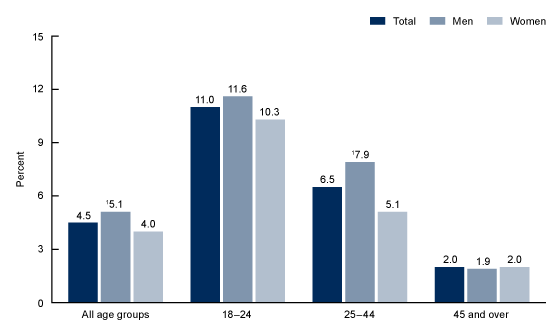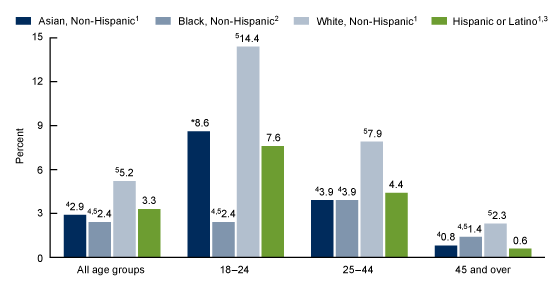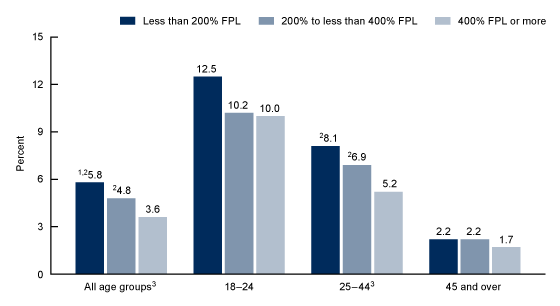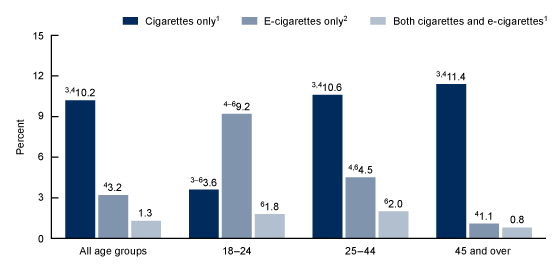Current Electronic Cigarette Use Among Adults Aged 18 and Over: United States, 2021
- Key findings
- In 2021, people aged 18–24 were most likely to use e-cigarettes among all adults.
- The percentage of adults who were current e-cigarette users varied by race and Hispanic origin.
- The percentage of adults who used e-cigarettes generally decreased as family income increased.
- Adults aged 18–24 and 25–44 were more likely to be dual users of e-cigarettes and cigarettes compared with adults aged 45 and over.
- Summary
Data from the National Health Interview Survey
- In 2021, 4.5% of adults aged 18 and over were current electronic cigarette (e-cigarette) users, with e-cigarette use highest among adults aged 18–24 (11.0%).
- Current e-cigarette use varied by race and Hispanic origin; among all adults aged 18 and over, the percentage of White non-Hispanic adults (5.2%) was higher than Asian non-Hispanic (2.9%), Black or African American non-Hispanic (2.4%), and Hispanic or Latino (3.3%) adults.
- E-cigarette use among adults aged 18 and over generally declined with increasing family income.
- Adults aged 18–24 and 25–44 were more likely to be dual users of e-cigarettes and cigarettes compared with adults aged 45 and over.
Use of electronic cigarettes (e-cigarettes) has increased among some adults (1–3). Reducing the use of any tobacco product, including e-cigarettes, is a Healthy People 2030 objective (4). E-cigarettes have the potential to benefit some adults who smoke and are not pregnant if they are used as a complete substitute for regular cigarettes or other tobacco products (5). However, concerns exist about dual use of e-cigarettes and cigarettes (6–9). Use of e-cigarettes among young adults is also a concern because nicotine adversely impacts brain development, which continues into the early to mid-20s (5,10). This report uses 2021 National Health Interview Survey data to describe the percentage of adults aged 18 and over who currently use e-cigarettes by selected sociodemographic characteristics and dual use of e-cigarettes and cigarettes.
Keywords: smoking, tobacco, vaping, race and Hispanic origin, National Health Interview Survey
In 2021, people aged 18–24 were most likely to use e-cigarettes among all adults.
- Among adults aged 18 and over, 4.5% were current e-cigarette users, and use was higher among men (5.1%) compared with women (4.0%) (Figure 1).
- Current e-cigarette use was highest among adults aged 18–24 (11.0%). The observed difference between men (11.6%) and women (10.3%) was not statistically significant.
- Among adults aged 25–44, current e-cigarette use was higher among men (7.9%) compared with women (5.1%). E-cigarette use was lowest among adults 45 and over, and use was similar for men (1.9%) and women (2.0%).
- Current e-cigarette use decreased with increasing age for both men and women.
Figure 1. Percentage of adults aged 18 and over who currently use e-cigarettes, by age group and sex: United States, 2021.

1Significantly different from women (p < 0.05).
NOTES: Men, women, and total men and women had a significant linear trend by age (p < 0.05). Current e-cigarette use was based on responses of “every day” or “some days” to the question, “Do you now use e-cigarettes or other electronic vaping products every day, some days, or not at all?” This question was asked of adults who had ever tried an e-cigarette, even one time. Estimates are based on household interviews of a sample of the U.S. civilian noninstitutionalized population. Access data table for Figure 1.
SOURCE: National Center for Health Statistics, National Health Interview Survey, 2021.
The percentage of adults who were current e-cigarette users varied by race and Hispanic origin.
- White non-Hispanic (subsequently, White) adults were more likely to be current e-cigarette users (5.2%) than Asian non-Hispanic (subsequently, Asian; 2.9%), Black or African American non-Hispanic (subsequently, Black; 2.4%), and Hispanic or Latino (3.3%) adults (Figure 2).
- Current use of e-cigarettes was highest among White adults compared with the other race and Hispanic-origin groups for all adults and for age groups 25–44 (7.9%), and 45 and over (2.3%). Among adults aged 18–24, e-cigarette use for White adults was higher than for Black and Hispanic or Latino adults.
- For Asian, Hispanic or Latino, and White adults, use of e-cigarettes declined with age. Among Black adults aged 45 and over, the percentage currently using e-cigarettes (1.4%) was lower than among those aged 25–44 (3.9%) but did not differ significantly from adults aged 18–24 (2.4%).
Figure 2. Percentage of adults aged 18 and over who currently use e-cigarettes, by age group and race and Hispanic origin: United States, 2021

*Percentage does not meet National Center for Health Statistics standards of reliability: confidence interval width is greater than 5 and relative confidence interval is greater than 130% (actual value confidence interval width = 15 and relative confidence interval width = 175.4%).
1Significant linear trend by age (p < 0.05).
2Significant quadratic trend by age (p < 0.05).
3People of Hispanic origin may be of any race.
4Significantly different from White, non-Hispanic adults (p < 0.05).
5Significantly different from Hispanic or Latino adults (p < 0.05).
NOTES: Current e-cigarette use was based on responses of “every day” or “some days” to the question, “Do you now use e-cigarettes or other electronic vaping products every day, some days, or not at all?” asked of adults who had ever tried an e-cigarette, even one time. Estimates are based on household interviews of a sample of the U.S. civilian noninstitutionalized population. Access data table for Figure 2.
SOURCE: National Center for Health Statistics, National Health Interview Survey, 2021.
The percentage of adults who used e-cigarettes generally decreased as family income increased.
- Among adults aged 18 and over, those with family incomes of less than 200% federal poverty level (FPL) (5.8%) were more likely to be e-cigarette users than those with family incomes 200% to less than 400% of FPL (4.8%) and those with family incomes of 400% FPL or more (3.6%) (Figure 3).
- Among adults aged 18–24, the observed difference in e-cigarette use among those with family incomes of less than 200% FPL (12.5%) compared with those with higher family incomes was not significant. Among adults aged 25–44, use decreased with increasing family income (from 8.1% to 5.2%), while use was similar by family income among adults aged 45 and over.
- At each level of family income, current use of e-cigarettes declined with age.
Figure 3. Percentage of adults aged 18 and over who currently use e-cigarettes, by age group and family income as a percentage of the federal poverty level: United States, 2021

1Significantly different from 200% to less than 400% FPL (p < 0.05).
2Significantly different from 400% FPL or more (p < 0.05).
3Significant linear trend by family income as a percentage of FPL (p < 0.05).
NOTES: Each family income group had a significant linear trend by age (p < 0.05). FPL is federal poverty level, which is based on a ratio of the family’s income in the previous calendar year to the appropriate poverty threshold defined by the U.S. Census Bureau. Current e-cigarette use was based on responses of “every day” or “some days” to the question, “Do you now use e-cigarettes or other electronic vaping products every day, some days, or not at all?” This question was asked of adults who had ever tried an e-cigarette, even one time. Estimates are based on household interviews of a sample of the U.S. civilian noninstitutionalized population. Access data table for Figure 3.
SOURCE: National Center for Health Statistics, National Health Interview Survey, 2021.
Adults aged 18–24 and 25–44 were more likely to be dual users of e-cigarettes and cigarettes compared with adults aged 45 and over.
- Among all adults aged 18 and over, 1.3% both smoked cigarettes and used e-cigarettes; 10.2% smoked cigarettes only and 3.2% used e-cigarettes only (Figure 4).
- Among adults aged 18–24, use of e-cigarettes only (9.2%) was higher compared with cigarette smoking only (3.6%) or use of both cigarettes and e-cigarettes (1.8%). Among adults aged 25–44 and 45 and over, use of cigarettes only was highest (10.6% and 11.4%, respectively) compared with e-cigarette use only or both.
- Adults aged 18–24 were less likely than adults aged 25 and over to smoke cigarettes only but were more likely to use e-cigarettes only. Use of both e-cigarettes and cigarettes was similar for adults aged 18–24 and 25–44 and higher for both groups compared with adults aged 45 and over (0.8%).
Figure 4. Percentage of adults aged 18 and over who currently smoke cigarettes and use e-cigarettes, by age group: United States, 2021

1Significant quadratic trend by age (p < 0.05).
2Significant linear trend by age (p < 0.05).
3Significantly different from e-cigarettes only (p < 0.05).
4Significantly different from both cigarettes and e-cigarettes (p < 0.05).
5Significantly different from adults aged 25–44 (p < 0.05).
6Significantly different from adults aged 45 and over (p < 0.05).
NOTES: Current e-cigarette use was based on responses of “every day” or “some days” to the question, “Do you now use e-cigarettes or other electronic vaping products every day, some days, or not at all?” This question was asked of adults who had ever tried an e-cigarette, even one time. Adults were asked if they had smoked at least 100 cigarettes in their lifetime and, if yes, whether they currently smoked cigarettes every day, some days, or not at all. Those who smoked every day or some days were classified as current cigarette smokers. The sum of e-cigarettes only and both cigarettes and e-cigarettes may not equal total e-cigarette use due to rounding. Estimates are based on household interviews of a sample of the U.S. civilian noninstitutionalized population. Access data table for Figure 4.
SOURCE: National Center for Health Statistics, National Health Interview Survey, 2021.
Summary
In 2021, 4.5% of adults aged 18 and over were current e-cigarette users, with people aged 18–24 having the highest levels (11.0%) compared with those aged 25–44 (6.5%) and 45 and over (2.0%). Men had higher percentages of e-cigarette use overall and among adults aged 25–44. E-cigarette use among those aged 18 and over was highest among White adults and those living in families with the lowest level of family income. Differences in current e-cigarette use by family income level among adults aged 18–24 and 45 and over, however, were not significant.
Dual use of tobacco products is a health concern because it may result in greater exposure to toxins and worse respiratory outcomes than using either product alone (6–9). In 2021, most e-cigarette users aged 18–24 had never smoked cigarettes (11). Despite this, the percentage of adults aged 18–24 who were dual users of e-cigarettes and cigarettes was similar to the percentage among adults aged 25–44 (1.8% compared with 2.0%). Adults aged 45 and over had the lowest levels of e-cigarette only use (1.1%) and dual use of e-cigarettes and cigarettes (0.8%).
Definitions
Cigarette smoking status: Adults were asked if they had smoked at least 100 cigarettes in their lifetime and, if yes, whether they currently smoked cigarettes every day, some days, or not at all. Those who smoked every day or some days were classified as current cigarette smokers.
Currently use e-cigarettes: Based on a response of “every day” or “some days” to the question, “Do you now use e-cigarettes or other electronic vaping products every day, some days, or not at all?” The question was asked of adults who had ever tried an e-cigarette, even one time.
Dual use of tobacco products: Refers to the use of e-cigarettes, smokeless tobacco, or other tobacco products in addition to regular cigarettes, usually in an attempt to cut back on smoking cigarettes (6). In this report, dual use considers regular cigarettes and e-cigarettes only.
Family income as a percentage of FPL: Based on FPL, which was calculated from the family’s income in the previous calendar year and family size using the U.S. Census Bureau’s poverty thresholds (12). Family income was imputed when missing (13).
Race and Hispanic origin: Adults were categorized as White non-Hispanic, Black or African American non-Hispanic, or Asian non-Hispanic when indicating one race only. Any non-Hispanic or Latino adults indicating multiple or other races are not shown distinctly but are included in the total. Hispanic or Latino respondents can be of any race or combination of races. Estimates for non-Hispanic adults of other races and other single and multiple races are not shown.
Data source and methods
The National Health Interview Survey is a nationally representative household survey of the civilian noninstitutionalized population. It is conducted continuously throughout the year by the National Center for Health Statistics. Interviews are typically conducted in respondents’ homes, but follow-ups to complete interviews may be conducted over the telephone. Because of the COVID-19 pandemic, interviewing procedures were disrupted, and during 2021, 62.8% of Sample Adult interviews were conducted at least partially by telephone (14). For more information about the survey, visit https://www.cdc.gov/nchs/nhis.htm.
Point estimates and corresponding variances for this analysis were calculated using SAS-callable SUDAAN software version 11.0 (15) to account for the complex sample design of the survey. All estimates are based on self-report and meet National Center for Health Statistics data presentation standards for proportions (16). Differences between percentages were evaluated using two-sided significance tests at the 0.05 level. Linear and quadratic trends by age group and family income were evaluated using orthogonal polynomials in logistic regression.
About the authors
Ellen A. Kramarow and Nazik Elgaddal are with the National Center for Health Statistics, Division of Analysis and Epidemiology.
References
- Bandi P, Cahn Z, Goding Sauer A, Douglas CE, Drope J, Jemal A, Fedewa SA. Trends in e-cigarette use by age group and combustible cigarette smoking histories, U.S. adults, 2014–2018. Am J Prev Med 60(2):151–8. 2021.
- Obisesan OH, Osei AD, Uddin SMI, Dzaye O, Mirbolouk M, Stokes A, Blaha MJ. Trends in e-cigarette use in adults in the United States, 2016–2018. JAMA Intern Med 180(10):1394–8. 2020.
- National Center for Health Statistics. Percentage of current electronic cigarette use for adults aged 18 and over, United States, 2019–2021. National Health Interview Survey.
- U.S. Department of Health and Human Services, Office of Disease Prevention and Health Promotion: Reduce current tobacco use in adults—TU 01.
- Centers for Disease Control and Prevention. About electronic cigarettes (e-cigarettes). 2023.
- Centers for Disease Control and Prevention. Dual use of tobacco products. 2022.
- Goniewicz ML, Smith DM, Edwards KC, Blount BC, Caldwell KL, Feng J, et al. Comparison of nicotine and toxicant exposure in users of electronic cigarettes and combustible cigarettes. JAMA Netw Open 1(8). 2018.
- Reddy KP, Schwamm E, Kalkhoran S, Noubary F, Walensky RP, Rigotti NA. Respiratory symptom incidence among people using electronic cigarettes, combustible tobacco, or both. Am J Respir Crit Care Med 204(2):231–4. 2021.
- Smith DM, Christensen C, van Bemmel D, Borek N, Ambrose B, Erives G, et al. Exposure to nicotine and toxicants among dual users of tobacco cigarettes and e-cigarettes: Population assessment of tobacco and health (PATH) study, 2013–2014. Nicotine Tob Res 23(5):790–7. 2021.
- U.S. Department of Health and Human Services. E-cigarette use among youth and young adults: A report of the Surgeon General. 2016.
- National Center for Health Statistics. QuickStats: Percentage distribution of cigarette smoking status among current adult e-cigarette users, by age group—National Health Interview Survey, United States, 2021. MMWR Morb Mortal Wkly Rep 72:270. 2023. DOI: https://dx.doi.org/10.15585/mmwr.mm7210a7.
- U.S. Census Bureau. Poverty thresholds. 2023.
- National Center for Health Statistics. Multiple imputation of family income in 2021 National Health Interview Survey: Methods. 2022.
- National Center for Health Statistics. National Health Interview Survey: 2021 survey description. 2022.
- RTI International. SUDAAN (Release 11.0.3) [computer software]. 2018.
- Parker JD, Talih M, Malec DJ, Beresovsky V, Carroll M, Gonzalez Jr. JF, et al. National Center for Health Statistics data presentation standards for proportions. National Center for Health Statistics. Vital Health Stat 2(175). 2017.
Suggested citation
Kramarow EA, Elgaddal N. Current electronic cigarette use among adults aged 18 and over: United States, 2021. NCHS Data Brief, no 475. Hyattsville, MD: National Center for Health Statistics. 2023. DOI: https://dx.doi.org/10.15620/cdc:129966.
Copyright information
All material appearing in this report is in the public domain and may be reproduced or copied without permission; citation as to source, however, is appreciated.
National Center for Health Statistics
Brian C. Moyer, Ph.D., Director
Amy M. Branum, Ph.D., Associate Director for Science
Division of Analysis and Epidemiology
Irma E. Arispe, Ph.D., Director
Julie D. Weeks, Ph.D., Acting Associate Director for Science
Division of Vital Statistics
Steven Schwartz, Ph.D., Director
Andrés A. Berruti, Ph.D., M.A., Associate Director for Science